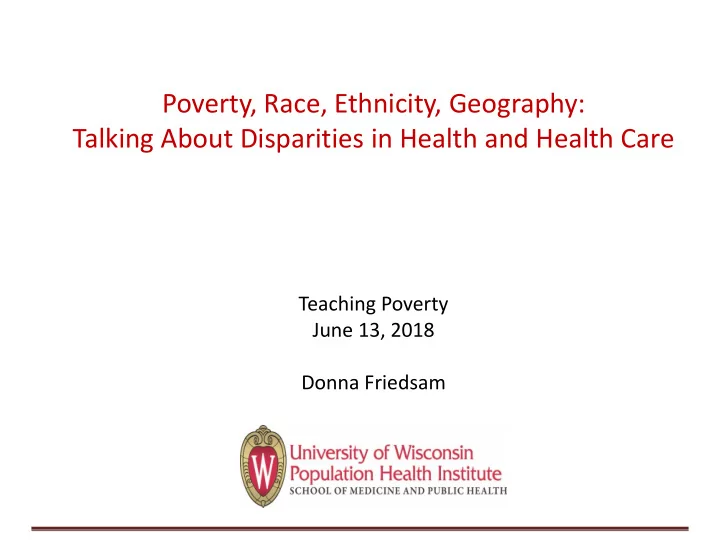

Poverty, Race, Ethnicity, Geography: Talking About Disparities in Health and Health Care Teaching Poverty June 13, 2018 Donna Friedsam
3
Current Narrative about Geography, Economic Status, and Race
“Deaths of Despair”: Case and Deaton Mortality and morbidity among white non-Hispanic Americans in • midlife increasing since 2000. Increases in drug overdoses, suicides, and alcohol-related liver • mortality, particularly among those with a high school degree or less Marked differences in mortality by race and education, with mortality • among white non- Hispanics (males and females), rising for those without a college degree, and falling for those with a college degree. Progressively worsening labor market opportunities. • Cumulative Disadvantages •
Case and Deaton specifically conclude: “increases have been seen at every level of residential urbanization in the United States; it is neither an urban nor a rural epidemic, but rather both.”
An Alternative Narrative: Crossing the Rural-Urban Divide Rates of access to care similar across all geographies, and are linked to income and other demographic factors. Access for the poor substantially worse than access for the non- poor across all geographies. Large affordability gap based on income, with substantially worse access rates for the poor than the nonpoor across all geographies.
An Alternative Narrative: Crossing the Rural-Urban Divide Rates of poverty are higher in cities and rural areas. About 17 million Americans in poverty live in the suburbs, more than the number living in poverty in cities or rural areas. Overall, the uninsurance rate is lower in suburban areas than in cities and rural areas. But… Nearly 40% of the uninsured population live in the suburbs. Aggregate data provide vague generalizations Blacks still have significantly higher fatality rates than white Americans, and the disparities remain entrenched.
An Alternative Narrative: Crossing the Rural-Urban Divide Financial, Geographic, Cultural, and Linguistic Barriers to Care Transportation and Geographic Barriers: Rural and Urban Availability of care • Mental health • Dental • Primary Care • Hospitals Consider how differences in income levels within geographies may affect access to care. Disaggregation by geography in data analysis necessary for identifying, monitoring, and attempting to eliminate health disparities among populations
14 Racial/ethnic disparities African Americans are more likely to die younger from all causes than white Americans. https://www.cdc.gov/vitalsigns/pdf/2017-05-vitalsigns.pdf Their experience with persistent disadvantage and related stress may produce allostatic load burdens that contribute to health disparities. https://www.ncbi.nlm.nih.gov/pmc/articles/PMC3417124/ Racial and ethnic minorities have worse access to health care and experience lower-quality care. https://www.kff.org/report-section/key-facts-on-health-and-health-care-by-race- and-ethnicity-section-2-health-access-and-utilization/ https://www.ahrq.gov/research/findings/nhqrdr/nhqdr16/quality.html#Disparities
15
16
Wisconsin IMR, 2013-2015 Non-Hispanic Whites: 4.71 per 1,000 African American: 14.28 per 1,000 Hispanic: 5.16 per 1,000
What about the “Hispanic Health Paradox”? Data vary based on longevity of time in the U.S. and exposure to U.S. diets, stresses, social support/networks Increasing morbidity rates, linked to increases in and higher rates of obesity, diabetes, and disability. Advantages in birth outcome erode with later generations in the U.S.
20
Does Health Insurance/Medicaid Matter?
24
Insurance and Financial Well-Being • Health insurance improves financial security. • Reduces out-of-pocket expenses, risk of large unpredictable medical costs. • Reduced bill collections and bankruptcies o Reduces the incidence of unpaid medical bills, provides substantial indirect financial benefits to households. (Brevoort D, Brodzicki D, Hackmann MB, NBER, November 2017) o …..and reduces stress. 25
Does Health Insurance/Medicaid Matter? Medicaid significantly increased the probability of having a usual source of primary care, the use of recommended preventive care, and the use of outpatient care, prescription drugs, and hospital care; improve self-reported mental health. (OHIE) Body of evidence indicates that coverage expansions significantly increase patients’ access to care and use of preventive care, primary care, chronic illness treatment, medications, and surgery. https://www.nejm.org/doi/full/10.1056/NEJMsb1706645
Uninsured Trends Wisconsin, 2013-2016 2013 Uninsured by Income Category, Wisconsin 2013-2016 2016 20.0% 18.4% 18.0% 15.0% 16.0% Substantial declines 14.0% 12.0% 10.1% 9.2% 8.8% in uninsured 10.0% 8.0% 5.5% 5.3% occurred across the 6.0% 3.8% 4.0% population. 2.0% 0.0% <138% FPL 138-199% FPL ≥200% FPL Total Population Largest declines in Uninsured by Race, Ethnicity, Wisconsin 2013-2016 rates of uninsured 40.0% occurred among 33.8% 35.0% persons in the 30.0% 25.0% 22.9% 25.0% 21.9% lowest income 20.0% 16.5% 15.0% 14.4% groups and among 15.0% 11.1% 10.1% 8.1% racial and ethnic 7.5% 7.3% 10.0% 6.8% 5.2% 4.5% 4.0% 5.0% minorities. 0.0% White alone Black or American Asian alone Some other Two or more Hispanic or White alone, African Indian and race alone races Latino (of any not Hispanic or American Alaska Native race) Latino alone alone
Plan Selections, 2017, Rural and Non-Rural, Compared to Overall Wisconsin Population 100% 90% 80% 70% 63% 70% 60% Non-rural 50% Rural 40% 30% 20% 37% 30% 10% 0% Plan Selections Wisconsin Population 28
Health Policy Programs Donna Friedsam, Director uwphi.pophealth.wisc.edu @UWHealthPolicy UW Population Health Institute – Wisconsin Health Insurance Coverage Chartpack 2016 Page 30
Recommend
More recommend